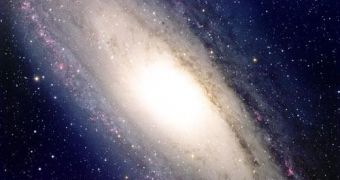Weighing supermassive black holes located in the center of galactic nuclei is more like looking through a solid brick wall, since matter in quantities of billions of times the mass of the Sun may stand in the way. Nonetheless, we are capable today to approximate the masses of supermassive black holes just by observing how that large amount of matter surrounding it moves through the space.
If the theory and calculations are correct, then the mass of a black hole in the center of a galactic nucleus should be in direct relation to the configuration of the galactic arms orbiting around it. For example, the larger the black hole, the tighter the galaxy's arms will wrap around it. Through this technique, astronomers would be able to approximate the masses of the black holes inside galactic nuclei as far as 8 billion light years away, nearly a thousand times the current distance to the farthest galaxy with the mass of the supermassive black hole resolved.
This new theory is suggested by a study made at the University of Arkansas, involving 37 spiral galaxies, amongst which our own and the Andromeda galaxy. According to Marc Seigar, leader of the study, galaxies containing relatively small supermassive black holes have their spiral arms outstretched to angles of up to 43 degrees, while galaxies containing some of the biggest supermassive black holes in the universe could have an outstretch as little as 7 degrees.
Stellar motion
Alternatively, astronomers also observed in previous occasions that there is a relation between the size of the galactic bulge in connection to the mass of the supermassive black hole at its center. However, estimating the size of a galactic bulge from very large distances introduces high uncertainties. A better way to approximate the size of a black hole would be to simply measure the orbital speeds of the stars in its vicinity. If stars have high motion speeds, it means that the galaxy contains a large supermassive black hole.
Albeit, star motion can only be measured to distances of a few tens of millions of light years away. "As you get farther away, basically that method gets harder to use - even with the Hubble Space Telescope - because you don't have the resolution to do it. The spiral arms are just easier to detect at very high distances," said Seigar.
Dark matter
Supermassive black holes don't offer us just an opportunity to study how galaxies evolved in time, but also to measure the mysterious matter which is thought to have shaped the whole universe, dark matter. Dark matter is thought to be responsible for the extra gravitational pull which seems to keep the universe from inflating too fast and it may also shape the arms of galaxies, the size of their galactic nuclei and the supermassive black holes.
For the next step of their study, the researching team will study distant active black holes, known as quasars, black holes 'feeding' with surrounding material, because they are much easier to measure than 'non-feeding', quiet black holes. Quasar masses can be measured to distances of up to 5 billion light years.
Seigar says that, in order to validate their theory, they must first prove that the relation between the galactic arms outstretch and the size of the supermassive black hole doesn't change as galaxies evolve. "We have to make sure the correlation itself doesn't evolve."

 14 DAY TRIAL //
14 DAY TRIAL //